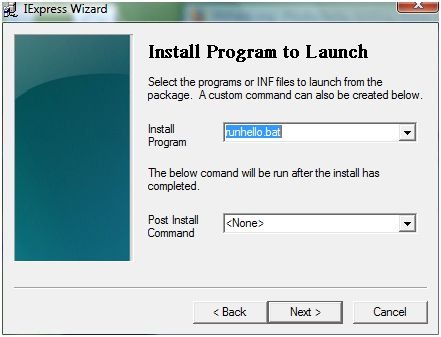

- IEXPRESS POST INSTALL COMMANDS HOW TO
- IEXPRESS POST INSTALL COMMANDS CODE

I recommend installing their latest LTS or current stable version.
Make sure you have Node.js and npm installed. Prerequisitesīefore we begin, we need some things setup first. 
With that, let’s start on how should we setup or project. So that’s the high-level view of how it works under the hood. We can leverage nodemon to restart our server every-time a file is changed. That’s why we’ll install a package called nodemon, that executes something whenever we change a file in our code. When coding in Node.js, automatic restart of our server doesn’t come out of the box just like when doing a project made on-top of create-react-app or vue-cli. And for that, there’s an existing package called rimraf. That’s why we need a script that removes files before the fresh transpiled copy enters. Whenever we change something in our code, we feed it to the transpiler, and it outputs a fresh copy every-time.
IEXPRESS POST INSTALL COMMANDS CODE
This is where the package called babel shines.īabel takes a js file, converts the code in it, and outputs into a new file. Note that in today’s time, almost 99% of ES6+ syntax can be used in Node.js. ES5 code is the JS syntax style that is readable to node.js, such as module.exports or var module = require('module'). We need a package that translates ES6 and above syntax to ES5 code. To enable a front-end development-like experience while developing back-end apps, here’s a high level view of the processes happening to your project. How does it work? A high level view of what we need
IEXPRESS POST INSTALL COMMANDS HOW TO
It will produce “ Our first maven program” as the output on the command prompt screen.Have you ever tried to write front-end apps using ES6 syntax, but then when you decided to learn back-end development with Node.js and Express, you realized that you can’t use stuff like import from and export default? If so, you came to the right place! This is step by step guide on how to configure your dev and prod environments, setup scripts, and as a bonus we’ll learn how to add tests! Table of Contents / Summary of topics We can quickly run our program using the below command. Now, run the same “ mvn install“, and the error shouldn’t come anymore.

We will now change the App class located in the src/main/java directory to print the message “ Our first Maven program“.
The test cases are located in the src/test/java directory, and the resources for the test are placed under the src/test/resources directory. Java classes are placed under the src/main/java directory, and the resources files are placed under the src/main/resources directory. This file describes the project, declares dependencies, etc. Every project will have a pom.xml( Project Object Model ) file. Let’s try to understand the project structure created using the command. Note: In earlier versions, we could have used the archetype:create instead of archetype:generate, but now the archetype plugin has removed the support for the create goal. The project has some default project structures shown in the screenshot below. The project will only be created after we give our confirmation If we don’t use this argument, then the interactive mode will be enabled, and it will ask us to confirm the project settings before creating our project. -DinteractiveMode=false argument will disable the interactive mode. Maven archetype plugin will create a folder or directly named DemoProject, the same as we passed in the artifactId argument in our command. Many archetypes are available in Maven almost for anything like creating a web application If we do not define the archetype using this argument, then it will prompt us to choose an archetype from a list of archetypes. archetype:generate helps create a project from an archetype that we have defined using -DarchetypeArtifactId=maven-archetype-quickstart. The -Dname=value pairs are the arguments passed to the goal, similar to what we do while passing system property options to the JVM via the command line mvn is the Maven2 command, and archetype:generate is a Maven goal. mvn archetype:generate -DgroupId= -DartifactId=DemoProject -DpackageName= -Dversion=1.0-SNAPSHOT -DarchetypeArtifactId=maven-archetype-quickstart -DinteractiveMode=false Run archetype:generate goal with the below command, which will create a new maven project for us. In this post, we will look at how we can create a simple maven project from the command line, and then we will run the same using the command line. It’s a project management tool that encompasses a project object model ( POM ), a set of standards, a dependency management system, and many more.








 0 kommentar(er)
0 kommentar(er)
